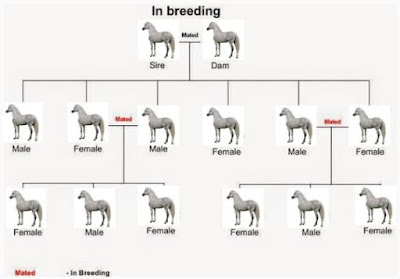Interest Inbreeding And Advantages And Disadvantages In Livestock
4:51 AM |
Crosses are inbreeding is a way that aims to find a pure strain of the descent so basically done a variety of ways to find the best strains. To get the maximum results inbreeding done by crossing a pure strain of several related breeds between generations so that the recession lethal genes that looks invisible. This will cause a shortage and kerungian miraculous.
Inbreeding is the mating between animals that have relatively closer kinship than the average of kinship with other animals in a population. In other words, inbreeding is a marriage between animals that have one or more common ancestor (common ancestor).
Inbreeding in cattle breeding is necessary to find a genetic advantage elders towards their children. But the degree should be limited not to do intensive continuously so that the loss due to inbreeding could not appear. As in dairy cattle, inbreeding coefficient should not reach more than 12%, since if more than 12%, then every increase of 1% would reduce the performance of the production and reproduction as well as the dairy cow health and increased mortality.
Crosses with inbreeding way has several advantages and disadvantages that would need to be known. By knowing these things, especially the loss gives us greater need to take that into account.
The following are the advantages of inbreeding:
1. Make individuals alike.
Inbreeding can cause cattle similar to each other, because inbreeding can lower heterozygotsitas levels in the population.
2. Preserving the desired properties.
If we liked a trait in a flock, these properties can be maintained by inbreeding.
3. Selection of the genes that are unwanted.
Inbreeding makes individuals homozygot. If there is lethal genes in homozygot circumstances, it would seem. Thus we can make the selection of the livestock carrier of the trait is not good.
4. It is the most excellent method to form a pure strain of herds of unknown origin.
5. Generated cattle according to desired needs.
The following is a disadvantage inbreeding:
1. The reduced number of gene pairs heterosigot, and the growing number of homozygous gene pairs.
2. Increase the frequency of homozygous recessive genotype animals, or collect genes that are less good. Some recessive lethal genes whose expression will appear when the homozygous recessive condition.
3. The high level of inbreeding that causes "pressure inbreeding" inbreeding depression) is characterized by the emergence of physical abnormalities such as short stature, abnormal jaw, and others.
4. Decreased appearance / performance of livestock.
On the chicken can create decreased egg production and increased mortality. In cattle, will lead to a decline in birth weight, vitality, weight and size and can decrease milk production and milk fat. While sheep may lead to the production of wool (quality and quantity) decreases.
Similarly, an article about the purpose of inbreeding as well as profits and advantages. may be beneficial to you.
Inbreeding is the mating between animals that have relatively closer kinship than the average of kinship with other animals in a population. In other words, inbreeding is a marriage between animals that have one or more common ancestor (common ancestor).
Inbreeding in cattle breeding is necessary to find a genetic advantage elders towards their children. But the degree should be limited not to do intensive continuously so that the loss due to inbreeding could not appear. As in dairy cattle, inbreeding coefficient should not reach more than 12%, since if more than 12%, then every increase of 1% would reduce the performance of the production and reproduction as well as the dairy cow health and increased mortality.
Crosses with inbreeding way has several advantages and disadvantages that would need to be known. By knowing these things, especially the loss gives us greater need to take that into account.
The following are the advantages of inbreeding:
1. Make individuals alike.
Inbreeding can cause cattle similar to each other, because inbreeding can lower heterozygotsitas levels in the population.
2. Preserving the desired properties.
If we liked a trait in a flock, these properties can be maintained by inbreeding.
3. Selection of the genes that are unwanted.
Inbreeding makes individuals homozygot. If there is lethal genes in homozygot circumstances, it would seem. Thus we can make the selection of the livestock carrier of the trait is not good.
4. It is the most excellent method to form a pure strain of herds of unknown origin.
5. Generated cattle according to desired needs.
The following is a disadvantage inbreeding:
1. The reduced number of gene pairs heterosigot, and the growing number of homozygous gene pairs.
2. Increase the frequency of homozygous recessive genotype animals, or collect genes that are less good. Some recessive lethal genes whose expression will appear when the homozygous recessive condition.
3. The high level of inbreeding that causes "pressure inbreeding" inbreeding depression) is characterized by the emergence of physical abnormalities such as short stature, abnormal jaw, and others.
4. Decreased appearance / performance of livestock.
On the chicken can create decreased egg production and increased mortality. In cattle, will lead to a decline in birth weight, vitality, weight and size and can decrease milk production and milk fat. While sheep may lead to the production of wool (quality and quantity) decreases.
Similarly, an article about the purpose of inbreeding as well as profits and advantages. may be beneficial to you.

0 komentar:
Post a Comment